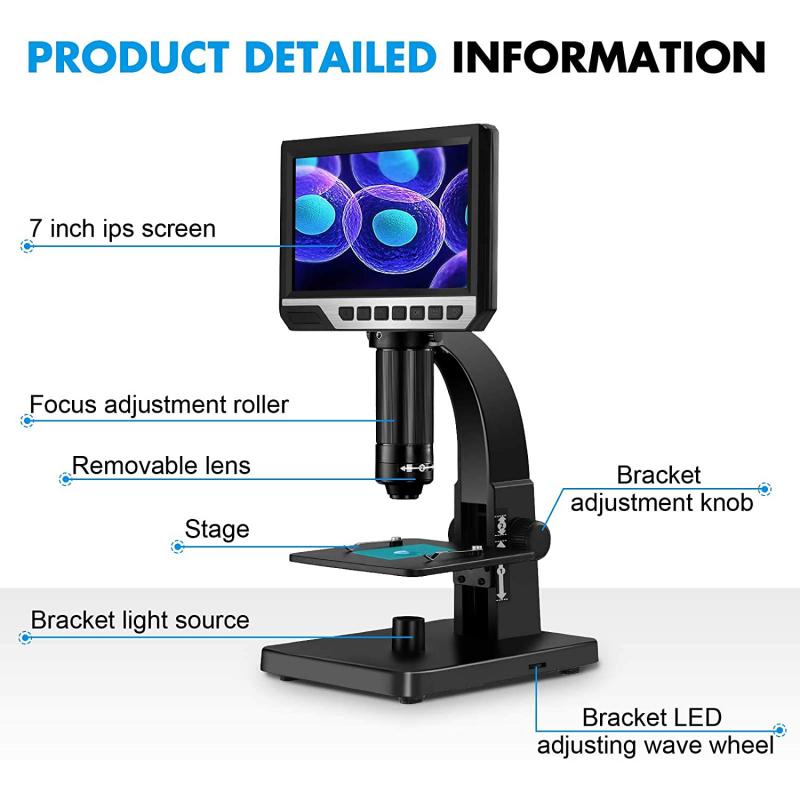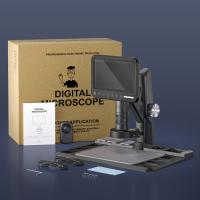What Microscope Can See Ribosomes ?
Electron microscopes are capable of visualizing ribosomes.
1、 Electron Microscope: Visualizing Ribosomes at High Resolution
Electron Microscope: Visualizing Ribosomes at High Resolution
The electron microscope is the most suitable microscope for visualizing ribosomes at high resolution. Ribosomes are small organelles found in cells that play a crucial role in protein synthesis. They are composed of RNA and proteins and are responsible for translating genetic information into proteins.
The electron microscope uses a beam of electrons instead of light to visualize the sample. This allows for much higher resolution imaging compared to light microscopes. The high resolution of the electron microscope enables scientists to observe ribosomes in great detail, including their structure and arrangement within the cell.
With the electron microscope, researchers can study the ribosomes at a molecular level, providing insights into their function and interactions with other cellular components. This level of detail is crucial for understanding the intricate processes of protein synthesis and how ribosomes contribute to cellular function.
In recent years, advancements in electron microscopy techniques have further enhanced our understanding of ribosomes. Cryo-electron microscopy (cryo-EM) has emerged as a powerful tool for studying ribosomes. This technique involves freezing the sample in a thin layer of ice, which preserves the ribosomes in their native state. By combining cryo-EM with sophisticated image processing algorithms, scientists can obtain high-resolution structures of ribosomes, revealing their intricate details.
Overall, the electron microscope, particularly with the advancements in cryo-EM, has revolutionized our ability to visualize ribosomes at high resolution. This has significantly contributed to our understanding of their structure and function, and continues to provide valuable insights into the complex world of protein synthesis.

2、 Cryo-Electron Microscopy: Revealing Ribosome Structure in Native Conditions
Cryo-Electron Microscopy: Revealing Ribosome Structure in Native Conditions
Cryo-electron microscopy (cryo-EM) is a powerful technique that has revolutionized the field of structural biology. It allows scientists to visualize biological molecules, such as ribosomes, in their native state, without the need for staining or fixation. This technique has provided unprecedented insights into the structure and function of ribosomes.
Ribosomes are essential cellular structures responsible for protein synthesis. They are composed of RNA and proteins and exist in all living organisms. Understanding the structure of ribosomes is crucial for deciphering the mechanisms of protein synthesis and for developing new antibiotics that target ribosomes.
Cryo-EM involves freezing samples in a thin layer of vitreous ice and imaging them using an electron microscope. The samples are maintained at cryogenic temperatures to preserve their native structure. This technique overcomes the limitations of traditional electron microscopy, which requires samples to be fixed and stained, potentially altering their structure.
In recent years, cryo-EM has been used to determine the high-resolution structures of ribosomes from various organisms, including bacteria, yeast, and humans. These studies have revealed the intricate details of ribosome structure and provided insights into their functional mechanisms.
The latest advancements in cryo-EM technology, such as the development of direct electron detectors and improved image processing algorithms, have further enhanced its capabilities. These advancements have allowed scientists to obtain higher resolution structures of ribosomes and other macromolecular complexes.
In conclusion, cryo-electron microscopy is a powerful technique that can visualize ribosomes in their native conditions. It has provided invaluable insights into the structure and function of ribosomes and has the potential to contribute to the development of new therapeutics targeting ribosomes.

3、 Atomic Force Microscopy: Imaging Ribosomes with Nanoscale Precision
Atomic Force Microscopy (AFM) is a powerful tool that can be used to visualize ribosomes with nanoscale precision. AFM is a type of scanning probe microscopy that uses a small probe to scan the surface of a sample and create a high-resolution image. Unlike other microscopy techniques, AFM does not rely on light or electrons to generate an image, making it suitable for imaging a wide range of samples, including biological molecules like ribosomes.
AFM works by scanning a sharp probe over the surface of a sample, measuring the forces between the probe and the sample. These forces are then used to create a topographic image of the sample's surface. By using AFM, researchers can obtain detailed information about the size, shape, and structure of ribosomes.
In recent years, AFM has been used to study ribosomes in various biological contexts. For example, researchers have used AFM to study the structure and dynamics of ribosomes during translation, the process by which ribosomes synthesize proteins. AFM has also been used to investigate the interactions between ribosomes and other molecules, such as antibiotics or regulatory proteins.
One of the advantages of AFM is its ability to image samples in their native environment, such as in solution or on a cell membrane. This allows researchers to study ribosomes in a more physiologically relevant context, providing insights into their function and behavior in real-time.
In conclusion, Atomic Force Microscopy is a powerful tool that can be used to visualize ribosomes with nanoscale precision. Its ability to image samples in their native environment makes it a valuable technique for studying the structure and function of ribosomes.

4、 Super-Resolution Microscopy: Enhancing Ribosome Visualization Beyond Diffraction Limit
Super-Resolution Microscopy: Enhancing Ribosome Visualization Beyond Diffraction Limit
Super-resolution microscopy techniques have revolutionized the field of cell biology by enabling scientists to visualize cellular structures with unprecedented detail. One such technique that has been instrumental in enhancing ribosome visualization is super-resolution microscopy.
Super-resolution microscopy overcomes the diffraction limit of conventional light microscopy, which restricts the resolution to approximately half the wavelength of light. This limitation has hindered the visualization of small cellular structures like ribosomes, which are typically around 20 nanometers in size.
By utilizing various super-resolution microscopy techniques such as stimulated emission depletion (STED) microscopy, structured illumination microscopy (SIM), and single-molecule localization microscopy (SMLM), researchers have been able to achieve resolutions beyond the diffraction limit. These techniques involve manipulating the fluorescence properties of the ribosomes or using specialized imaging algorithms to precisely localize individual ribosomes.
The enhanced visualization of ribosomes using super-resolution microscopy has provided valuable insights into their organization and dynamics within cells. It has allowed researchers to study ribosome clustering, ribosome distribution on the endoplasmic reticulum, and ribosome interactions with other cellular components.
Furthermore, recent advancements in super-resolution microscopy have further improved ribosome visualization. For example, the development of new fluorescent probes specifically designed for super-resolution imaging has increased the brightness and photostability of ribosome labeling. Additionally, the combination of super-resolution microscopy with other imaging modalities, such as electron microscopy, has allowed for correlative imaging, providing a more comprehensive understanding of ribosome structure and function.
In conclusion, super-resolution microscopy techniques have significantly enhanced the visualization of ribosomes beyond the diffraction limit of conventional light microscopy. These advancements have provided valuable insights into the organization and dynamics of ribosomes within cells. With ongoing developments in super-resolution microscopy, we can expect further improvements in ribosome visualization and a deeper understanding of their role in cellular processes.































There are no comments for this blog.